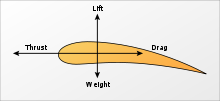- Aerodynamic force
-
Aerodynamic force is exerted on a body by the air (or some other gas) in which the body is immersed, and is due to the relative motion between the body and the gas. Aerodynamic force arises from two causes: [1] [2] [3]
- the force due to the pressure on the surface of the body, and
- the force due to viscosity, also known as skin friction.
When an airfoil (or a wing) is moving relative to the air it generates an aerodynamic in a direction at an angle with the direction of relative motion. This aerodynamic force is commonly resolved into two components:[4][5]
- drag is the force component parallel to the direction of relative motion,
- lift is the force component perpendicular to the direction of relative motion.
The force created by a propeller or a jet engine is called thrust and it is also an aerodynamic force (since it also acts on the surrounding air). The aerodynamic force on a powered airplane is commonly resolved into three components: thrust, lift and drag.[6][7]
The remaining other force acting on a glider or powered airplane during flight is its weight. Note that weight is a body force, and it is not an aerodynamic force.
See also
References
- Hurt, H.H.Jr. Aerodynamics for Naval Aviators. A National Flightshop Reprint, Clearwater, Florida (1979)
- Clancy, L.J. (1975). Aerodynamics. Pitman Publishing Limited, London. ISBN 0-273-01120-0
- Massey, B.S. Mechanics of Fluids, 2nd Edition. Van Nostrand Reinhold Co., London (1970) Library of Congress Catalog Card No. 67-25005
Notes
- ^ Hurt, H.H.Jr. Aerodynamics for Naval Aviators. p.29
- ^ Clancy, L.J. Aerodynamics. Section 4.10
- ^ Massey, B.S. Mechanics of Fluids, section 10.8.2
- ^ Hurt, H.H.Jr. Aerodynamics for Naval Aviators. p.14
- ^ Clancy, L.J. Aerodynamics. Section 5.3
- ^ Hurt, H.H.Jr. Aerodynamics for Naval Aviators. Fig 2.20
- ^ Clancy, L.J. Aerodynamics. Section 14.2
Categories:- Fluid dynamics stubs
- Aerodynamics
Wikimedia Foundation. 2010.

